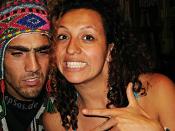Ember (2002, p.343) defines marriage as "a socially approved sexual and economic union, usually between a woman and a man". Because marriage customs differ widely according to culture, it is obviously of great interest to the cultural anthropologist. For example, marriage rites in some cultures may involve highly complex ceremonial rituals, whereas marriage rites in other cultures may be relatively simple. The Chinese (in this essay, meaning native inhabitants of China) seem to have an affinity for elaborate rituals; like other Chinese celebrations, a traditional Chinese marriage involves several elaborate rituals, some of which are performed before the actual wedding day. This essay will examine each part of the wedding from the perspective of a particular Chinese subculture.
'Visiting girls' is a courtship ritual practiced by the Dai ethnic group that typically takes place during the agricultural slack season (An & Liu, 2002). When the lights in their houses have been put out, bonfires are built outside the village (ibid).
Young women sit around the fires with their spinning wheels (ibid). Young men drape themselves with red blankets and walk around the young women as they play musical instruments (ibid). When a young man sees a young woman who strikes his fancy, he approaches her slowly (ibid). If the attraction is mutual, the young woman takes out a small stool which has been concealed under her long skirt and invites him to sit beside her (ibid). The young man then seats himself and wraps his red blanket around the young woman (ibid). A heart-to-heart talk then ensues (ibid).
Two weeks before the wedding takes place, the Hokkien matchmaker delivers the dowry money to the bride's parents inside a red packet (Blu Inc Media (S) Pte Ltd., 1999). This traditional practice is known as "lup chai" (ibid). It is considered good...


